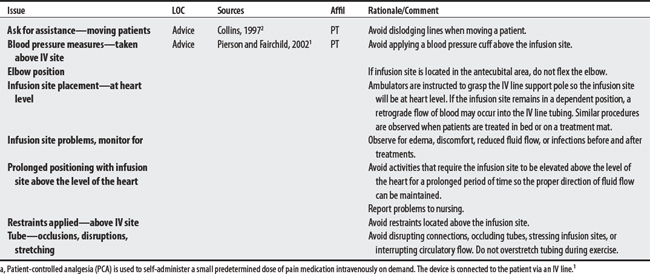Chapter 34 Supportive Devices
34.1 Elastic Supports (Compression Supports)
OVERVIEW.
An elastic support is an article of clothing that offers some degree of compression around a body part in order to help prevent DVT (16-18 mm Hg—antiembolism stocking), control scar formation (20-30 mm Hg), control edema in ambulators (30-40 mm Hg),1 or assist in venous circulation return.2 An example of an elastic support is a compression garment.
SUMMARY: CONTRAINDICATIONS AND PRECAUTIONS.
Two sources list seven concerns for compression supports. Concerns ranged from four to six per source; three shared issues included (1) treating edema, (2) peripheral artery disease, and (3) donning difficulties. The concerns of Scholten et al3 are targeted to a stroke population. The FDA4 has received reports of neuropathy and skin blistering as a possible complication of compression support therapy.
1 Cameron MH. Physical agents in rehabilitation: from research to practice. St. Louis: Saunders, 2003.
2 Pierson FM, Fairchild SL. Principles and techniques of patient care, ed 3. Philadelphia: Saunders, 2002.
3 Scholten P, Bever A, Turner K, et al. Graduated elastic compression stockings on a stroke unit: a feasibility study. Age Aging. 2000;29(4):357-359.
4 U.S. Food and Drug Administration. Center for Device and Radiological Health. Available at: http://www.fda.gov/cdrh/mdr/. Accessed on November 7, 2005
5 Redford JB. Orthotics etcetera. Baltimore (MD): Williams & Wilkins, 1986.
34.2 Lines
Lines are medical devices that use tubing to infuse fluid, infuse or obtain blood, or monitor hemodynamics. Whereas central lines access a patient’s heart from a peripheral vessel, peripheral lines access the patient’s circulation from a peripheral vessel. Intracranial pressure (ICP) monitors measure the pressure of brain tissue against the skull.1,2 Concerns when treating patients who have these lines are listed below.
A critical concern when treating patients is the dislodgment of IV lines or catheters because it can lead to a fatal air embolism. See Philips and Lee (1990),3 Zafonte et al (1996),4 and an Ohio lawsuit5 below.
PERIPHERAL LINES
Arterial Lines (A Line)
Arterial lines are peripheral lines, inserted into the artery (e.g., radial, dorsal, pedal, axillary, brachial, or femoral) to continuously measure blood pressure or obtain blood samples.2
Intravenous (IV) Infusion Lines
Intravenous (IV) infusion lines are peripheral lines used to obtain venous blood samples, to infuse fluids, nutrients, electrolytes, or medication, or to insert catheters into the central circulatory system to monitor physiologic conditions.1 IV line precautions also apply to patient-controlled analgesia (PCA).1a
< div class='tao-gold-member'>
Stay updated, free articles. Join our Telegram channel

Full access? Get Clinical Tree















